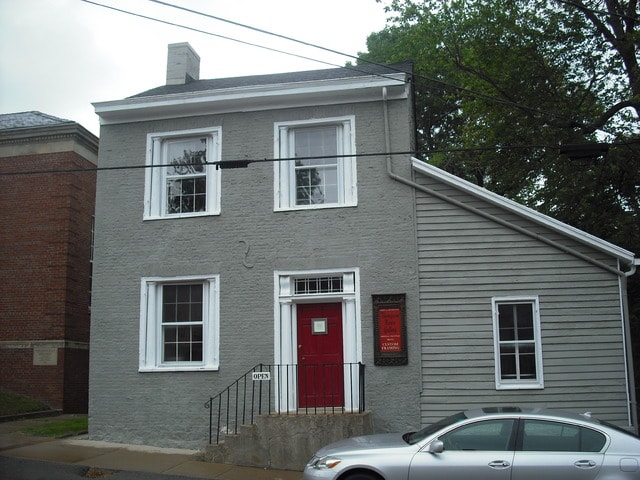
By Meghann MacMillan


GEORGETOWN — John Ruthven has long been heralded as the “20th century Audubon.”
His work has been featured across the globe including the President’s Palace in the Philippines, the Hermitage Museum in St. Petersburg and the White House. He has traveled, studied and painted for more than 70 years, but there is more to Ruthven than just his art.
Ruthven was born poor to a loving family in Walnut Hills. From a very early age, he enjoyed walking, exploring and recording things in his sketch book. Different from his sports-loving brothers, Ruthven enjoyed solitary activities and thought of himself as a “dreamer.”
For Ruthven, the mystery and magic behind painting began in those long walks around Cincinnati with a pencil and sketchbook in hand.
Ruthven remembers quite clearly the day that Audubon’s art came down the Ohio River to tour in Cincinnati. At 9 years old, Ruthven made the long walk to the river by himself in order to view some of Audubon’s work.
“Not a big deal in those days,” Ruthve admitted, but certainly unimaginable today.
Inspired by the incredibly detailed paintings of Audubon, Ruthven began to dream of what it must have been like to be a frontiersman exploring new species as Audubon had done.
“I felt I had been born 100 years too late,” Ruthven said.
His teachers and parents began to see his potential and encouraged him to practice his art. He was asked to paint sets for the school play and was even asked to play the lead of Daniel Boone, a role Ruthven, because of his love of frontiersmen, was born to play.
Ruthven continued to study Audubon’s techniques and practice his art. He could think of no better way to live his life, but life had other plans for Ruthven.
In 1939, World War II began and, as the fight raged overseas, Ruthven found himself serving most of his college years in the Navy chasing German submarines. He came home, four-and-a-half years later, and finally returned to his passion.
When Ruthven opened his first studio in 1946, he was a starving artist. In order to drum up business, he placed a sign outside his studio saying he would draw anything.
Ruthven joked, “And if you say anything, you have to mean anything.”
Only a month after his studio opened, a man approached him for some cartoon work. Although not his preferred art, Ruthven consented to create a cartoon boy for the man. The man worked for Play-Doh, a Cincinnati company hoping to rescue its product by marketing it as a children’s toy. The venture was a success and, for Ruthven, became the first step in securing his future as an artist.
The turning point, Ruthven claimed, was the 1960 Duck Stamp Competition. Ruthven entered his painting, “Redhead Ducks,” and won.
“It was a defining moment,” Ruthven said.
From there, Ruthven’s reputation as a wildlife artist spread. Requests for commissions soon followed and Ruthven became a household name.
Yet, behind the “20th century Audubon” was still a man fascinated by birds and their natural habitat.
Ruthven recalled walking down 4th street in Cincinnati in a suit and tie. He was running a bit late for a meeting when suddenly a bird dropped out of the sky and landed on the sidewalk directly in front of him.
Ruthven, ever curious, examined the bird and, with the exception of a broken neck, deemed it a perfect specimen. He was at an impasse. He couldn’t take the bird home and make it to his meeting, and he didn’t want to leave it until afterwards for fear of someone damaging it, so Ruthven placed the dead bird in his suit pocket and continued on to his meeting.
“No one knew I had a dead bird in my pocket,” Ruthven joked.
His laugh was genuine and warm but, behind the silly story of one dead bird, was a larger tale of a man living his dream.
When asked what artists need to make a career out of their art, Ruthven was able to sum it up in one word: perseverance. “Don’t give up” is Ruthven’s motto. Every artists goes through specific periods in their career.
The starving artist period, according to Ruthven, is unavoidable and future artists must “prepare themselves for it.” Aside from that, Ruthven advises that anyone looking to make a career out of art needs to promote themselves and not be afraid to talk about their talent.
Now. Ruthven lives a busy life bouncing back and forth between Cincinnati and his gallery in Georgetown, but he still makes time for long walks and chats with new friends.
MEGHANN MacMILLAN
Meghann has lived in the country all her life and loves it more every day. She raises chickens, rabbits and two adorable children with her husband in Brown County.
ID, 'source', true); $sourcelink = get_post_meta($post->ID, 'sourcelink', true); $sourcestring = '' . __('SOURCE','gabfire') . ''; if ($sourcelink != '') { echo "
$sourcestring: $source
"; } elseif ($source != '') { echo "$sourcestring: $source
"; } // Display pagination $args = array( 'before' => '' . __('Pages:','gabfire'), 'after' => '
', 'link_before' => '', 'link_after' => '', 'next_or_number' => 'number', 'nextpagelink' => __('Next page', 'gabfire'), 'previouspagelink' => __('Previous page', 'gabfire'), 'pagelink' => '%', 'echo' => 1 ); wp_link_pages($args); // Display edit post link to site admin edit_post_link(__('Edit','gabfire'),'','
'); // Post Widget gab_dynamic_sidebar('PostWidget'); ?>